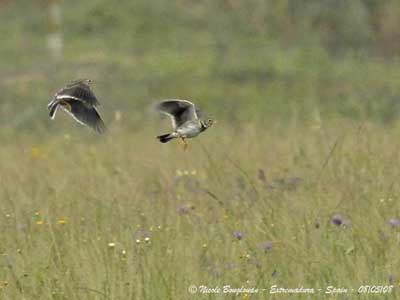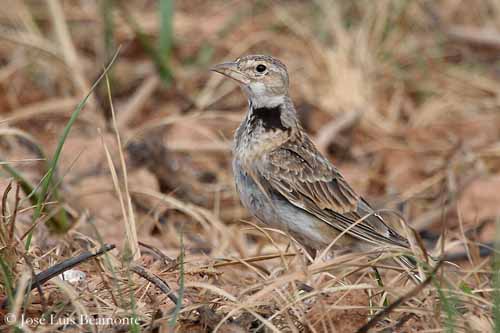
Fr: Alouette calandre
All : Kalanderlerche
Esp : Calandria Común
Ital: Calandra
Nd: Kalanderleeuwerik
Sd: Kalanderlärka
Photographers:
Jose Luis Beamonte
Pájaros de España
Nicole Bouglouan
PHOTOGRAPHIC RAMBLE
Text by Nicole Bouglouan
Sources:
HANDBOOK OF THE BIRDS OF THE WORLD Vol 9 - by Josep del Hoyo - Andrew Elliot - David Christie - Lynx Edicions - ISBN: 8487334695
THE HANDBOOK OF BIRD IDENTIFICATION FOR EUROPE AND THE WESTERN PALEARCTIC by Mark Beaman, Steve Madge - C.Helm - ISBN: 0713639601
BIRDS OF THE MIDDLE EAST by R.F. Porter, S. Christensen, P Schiermacker-Ansen C.Helm - ISBN: 0713670169
ENCYCLOPEDIE DES OISEAUX DE FRANCE ET D’EUROPE – de Peter Hayman et Rob Hume - Flammarion – ISBN : 2082009920
Pájaros de España (JL Beamonte)
BirdLife International (BirdLife International)
Calandra Lark
Melanocorypha calandra
Passeriforme Order – Alaudidae Family
BIOMETRICS:
Length: 18-20 cm
Weight: M: 54-73 g – F: 44-66 g
DESCRIPTION:
The Calandra lark is the bulkiest species of this family.
Adult male in breeding plumage has greyish-brown upperparts with blackish streaks. In spite of the pale-edged feathers of the back, this bird appears very dark, almost black when flying, as well seen from above as for below. Chin and throat are white, like lower breast and belly. Upper breast is pale buff streaked brown.
When in flight, we can see the white spots on primary and secondary feathers, contrasting with the dark plumage.
On the neck side, at the base, there is an elongated black spot.
The short tail is blackish-brown, with the two outer rectrices mainly white.
The bill is strong, conical, and down-curved on culmen, with darker upper mandible. The lower mandible is yellow. Legs and feet are yellowish-brown. Eyes are brown.

Both sexes are similar, but female has less conspicuous black neck spots.
The juvenile is paler than adults, and the dark breast spots are less distinct.
We find four subspecies.
M.c calandra is found in Spain, S France, eastwards in S Russia and NW Kazakhstan, also on Mediterranean islands to NW Africa, in some parts of Turkey and in NW Iran.
M.c. hebraica is found in other parts of Turkey, and from NW Syria to Israel, Palestine and W Jordan.
M.c. gaza lives in SE Turkey, E Syria, Iraq and SW Iran.
M.c. psammochroa is found in N Iran and Iraq, in Turkmenistan and E Kazakhstan.
These races differ in plumage colour, with variations of grey and cinnamon, and the dark breast spots are more or less conspicuous.
VOICE: SOUNDS BY XENO-CANTO
As soon as March, the males sing very loudly. The Calandra Lark’s song is very loud, with melodious notes, often interspersed with harsh tones which make the melody less strong and pleasant than expected.
This bird is able to mimicry the song of other birds’ species. The flocks utter their nasal chatters in the harvested corn or barley fields “klitrr”.
The song flight includes high-pitched trills.
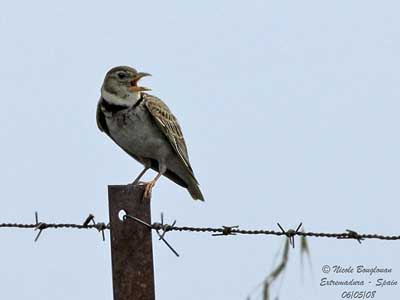
HABITAT:
The Calandra Lark frequents large plains, grassy steppes and cereal cultivated areas. But according to the range, it also may be found in more arid areas with scarce vegetation.
Usually, this species avoids desert or semi-desert, and stony areas. It lives mainly in lowlands, but in Spain, it is visible up to 1400 metres of elevation.
RANGE:
The Calandra Lark is resident in S and E of Europe, and in North Africa. Outside the breeding season, some movements are observed. Some populations such as those of E Europe, are migratory or partially migratory, and spend the winter from S Russia to North Africa, and in S Iraq and Iran.
See above for the subspecies.
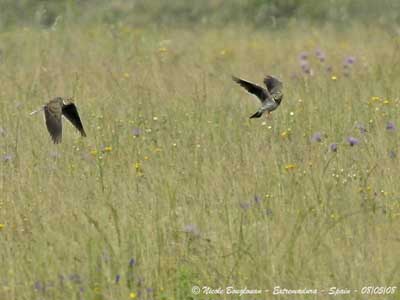
BEHAVIOUR:
When alarmed, the Calandra Lark crouches briefly instead to take off immediately.
When taking off, it starts to sing while rising in the air by circling, and when it reached some height, it soars and circles during several minutes over its territory, descending until about 80-100 metres from the ground, and then, goes into a dive to the ground.
The Calandra Lark is territorial and chases intruders in flight. The birds are facing up to each other and perform chases while calling.
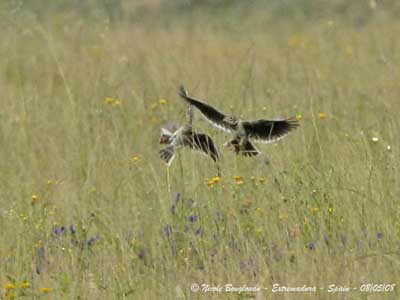
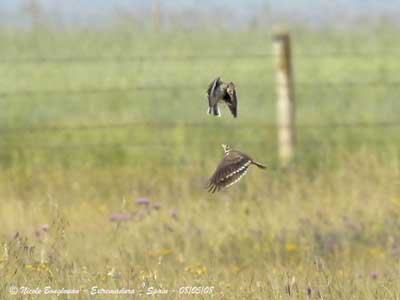
The Calandra lark often stands upright. It runs while foraging and probing into the soil. It digs with the bill to find some larvae, and also uses it to break the frozen snow during winter. It also may hover to catch insects from bushes.
This species forages alone or in flocks including sometimes very numerous birds, and also other birds’ species such as the Corn Bunting outside the breeding season.
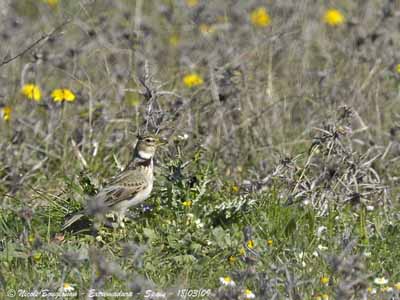
FLIGHT:
The Calandra Lark’s flight is very typical. It circles or remains almost motionless at some height, performing slow, deep wing beats on stiff wings and closed tail.
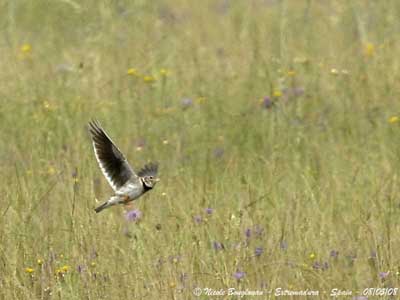
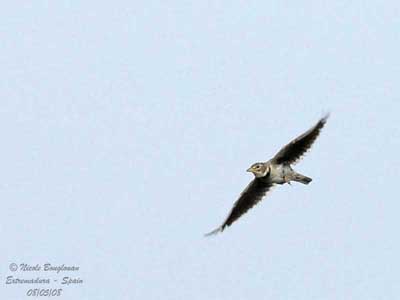
REPRODUCTION:
The Calandra Lark nests on the ground, often sheltered by some plant, tussock or small bush, and rarely in open. It also may take advantage of some depression in the ground, while preferring the cereal fields.
This species is monogamous and nests solitary, but if the numbers are important, they can breed in very loose colonies.
The female builds the nest with dry grasses, stems or straw, and the interior is lined with fine grass.
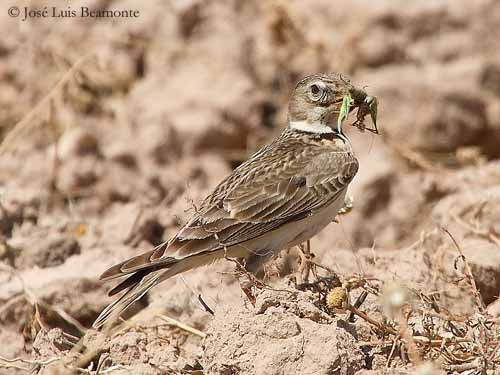
The laying starts in late April. The female lays 4-5 greenish eggs. They become whitish with numerous dark brown or grey markings after some days of incubation. The female incubates alone during about 12-14 days. The chicks are very robust and fledge at 11-12 days of age, after to be fed by both parents. But they will fly only at about 20 days after hatching, when they will be well feathered.
This species produces two broods per season.
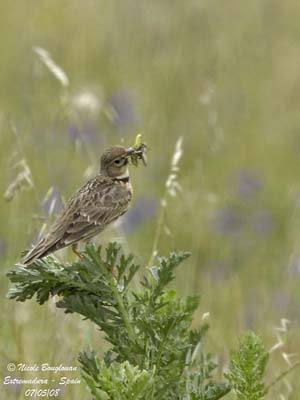
DIET:
The Calandra Lark feeds primarily on vegetal items. During fall and winter, it consumes numerous seeds and cereals, shoots, grass and mainly hemp seeds.
From April, it takes a lot of insects, grasshoppers, caterpillars, spiders, small molluscs and earthworms.
PROTECTION / THREATS / STATUS:
The Calandra Lark suffers some declines, although it is still widespread in several parts of the range. The species is probably threatened by the use of pesticides in the fields. The changes in agriculture (more olive groves and vineyards and less cereal crops), deforestation and increase of livestock also have negative effects.
These declines occur primarily in France, Italy, Greece and Spain.
However, this species is not threatened at this moment.
